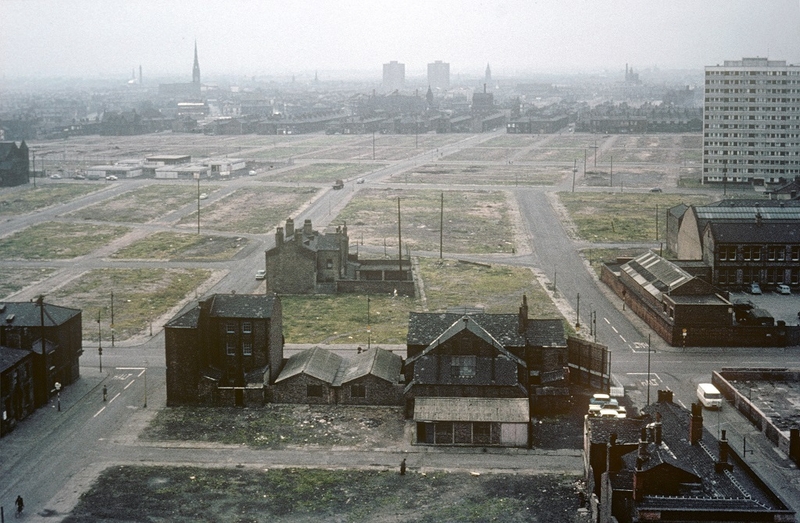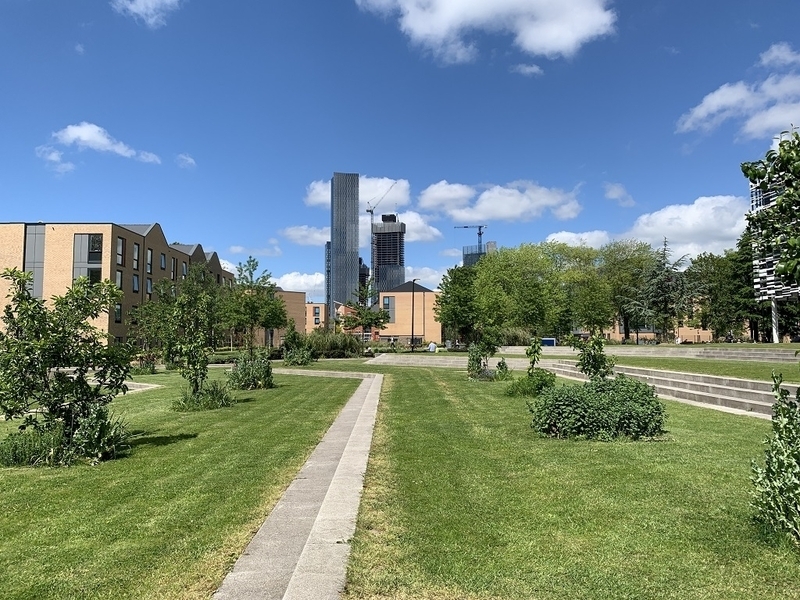Jonathan Schofield on Richard Davis' Hulme book, nostagia and reality
From Nikolaus Pevsner’s The Buildings of England, South Lancashire, 1969:
‘Hulme is so far the largest development area of Manchester, many say of England, and some of Europe. At the time of writing whole blocks lie waste, streets are blocked, and new streets are made. The whole area is 350 acres.
‘Industrial housing under Mr J Austin Bent, the Director of Housing, remains visibly indifferent, and, even where much care has been taken on the designing of the facades, socially dubious. Do we really want these towers of flats everywhere? Do tenants want them? Should they be accepted as living conditions by any but bachelors, spinsters, young couples without children, and old people. Will they not be the slums of fifty years hence?’
In the 1980s Richard Davis arrived in Hulme from Birmingham. He was at the Polytechnic, now Manchester Metropolitan University, and he was told to avoid 'dangerous and lawless' Hulme. He didn't listen. Now, he has a photo-record of his time in Hulme in the early eighties and early nineties released titled, Richard Davis - Hulme 1980s-90s.
His photos provide a fascinating insight into life in this notorious suburb at its most notorious. By the 1980s Hulme had, as Pevsner predicted in the passage above, become a slum, but not 'fifty years hence', it had taken less than ten. He was right about it becoming a preserve of young people and singletons too but got it totally wrong about old people, they'd abandoned it - if they could.
For Davis and many others, the anarchy that followed, carries a golden glow, standing out as a period of creativity and freedom.
Hulme was ideal to use as a backdrop for my photos, all full of concrete and strange walkways in the sky and an amazing lack of colour
Owen Hatherley in his 2010 book, A Guide to the New Ruins of Great Britain - a book which asks us to reconsider the post-war reconstruction of the UK and compare it with the buildings erected since 2000 – talks about the Hulme Crescents as a ‘creative space’. He admits the faults of the buildings when it came to families but admires them as ‘perfect’ for the counter culture.
Hatherley quotes Liz Naylor; a fanzine editor and a person familiar with Manchester’s music scene in the seventies and eighties who, after running away from home, asked for a flat in Hulme because it had acquired ‘a population of alternatives’. Naylor in Various Times wrote how the Cresents ‘became almost an independent city, another town within a town with a shifting stream of young, single people with their own dress codes.’
In an interview with Paul Wright for Cafe Royal Books, Davis says, "I took to Hulme straight away, how could you not? It was just so damn photogenic and so very different from anywhere I’d seen before. A lot of it was derelict, whilst what was occupied tended to consist of a diverse mix of artists, musicians, drop-outs, ex-students and the unemployed, the kind of people mainstream society seemed to reject."
Let's hear more from Davis.
"(Hulme)' he says, "had the most amazing creative spirit and sense of community, and for a lot of people a real source of inspiration and get up and go energy. I quickly made friends with various musicians and word got out I had a camera and knew how to use it, it was that easy. Remember this was well before mobile phones and Manchester at that time didn’t have many photographers.
"After only a few months in Manchester I got offered the keys to a squat in one of the four big crescents in the heart of Hulme. The place used to belong to Harry Stafford from Manchester band The Inca Babies, turns out I could have his flat as long as I forwarded all the mail to him that his band used to receive. I was in heaven, I had my own rent free place which I converted into a darkroom and studio.
'The flat had no windows at the front, all boarded up, this was perfect no light would get in. The only problem was keeping the temperatures of the chemicals consistent for developing and printing photos, this was difficult in winter as it was so damn cold, the flat only had one plug-in heater. Hulme was ideal to use as a backdrop for my photos, all full of concrete and strange walkways in the sky and an amazing lack of colour which really suited what I was after."
The picture Davis and others paint is of Hulme as Freetown Christiana in Copenhagen. It certainly attracted a sort of whos-who of Mancs and adopted Manc 'faces' of the time. Davis, himself, became friends with Henry Normal, Steve Coogan, Caroline Aherne and others.
There was the Russell Club, where, in effect, Factory Records was born, and a famous cinema, the Aaben. It’s also true that some flats were knocked together to form a recording studio and that band members of Manchester groups such as Joy Division, The Smiths, A Certain Ratio and even Simply Red lived there for a while.
Davis, Naylor and others, it does seem, for them, lived in a charmed time. But it was never going to last. The sixties design by Wilson & Womersley (they also designed Manchester Arndale, bless 'em) aided and abetted appalling crime levels. If there was a Boho experiment taking place in Hulme it was dramatically unsustainable, and had never been intended.
However, any romantic revision of Hulme Crescents leaves out perhaps the worst aspect of their creation in the sixties and seventies. This was the social engineering whereby poorer central populations were shifted to council estates many miles from the city without consultation. Isolated in inward looking communities with poor access to jobs and as the regional economy declined these inevitably became sink estates.
I once talked to Jean Sutcliffe who’d lived in the former high density 19th century housing. This was ‘slum-cleared’ and she was moved to Hattersley, a council estate in the foothills of the Pennines, near Glossop.
"We were city people, you know," she said. "It was a fifteen minute walk to the city centre shops such as Lewis’s and Kendals, we had all the pubs and shops on Stretford Road as well. Suddenly we were in flats on the moors, and we weren’t asked, we were just told it was good for us. There wasn’t even a pub open when we arrived and it was more than an hour back into ‘town’ on the bus.”
The 1960s' redevelopment of Hulme left the district with 12,000 residents, in the 1930s there had been 130,000. By the time of demolition in the nineties there were less than 5,000. The area had been fully redeveloped by 1972; by 1995, the Crescents and most of the concrete blocks had been demolished. It was in effect a very expensive failure that lasted just a single generation.

The pictures on this page, and in Richard Davis' book capture a particular and very odd Robin Hood/outlaw time in Hulme. There are people and personalities from the time, yet, the coldness of the environment he depicts is terrifying.
For someone who visited the Crescents and saw them in the flesh and watched them disappear, the pictures almost make the hairs stand up on the back of my neck. Memory plays tricks, the past becomes mutable. Davis's images, as often with relatively recent documentary work, seem almost more distant and alien than images from way earlier. They are akin to looking through binoculars backwards, a familiar image emerges, but distorted and changed.
Davis again: "What's interesting, years later, is looking back and everything you see is no longer there, the whole area gone, completely bulldozed. A new Hulme grew up in the late 1990s with better housing and normal facilities, families moved back into the area, but you know what ........ I really miss the old place, it was totally unique."
You can buy Richard Davis' book here from Cafe Royal Books, £6. Thanks to Paul Wright and The British Culture Archive.
From Manchester: 50 years of change by Manchester Planning Committee, 1995:
‘The best-known part of the Hulme redevelopment was referred to commonly as the Crescents, four huge curved blocks of flats and maisonettes linked together by walkways and bridges. The architects, Wilson and Womersley, compared their project to Georgian Bath, believing they had achieved an equivalent solution to satisfy twentieth century urban living.
‘By 1972 the redevelopment of Hulme was virtually complete. Over 5,000 new homes had been built in less than eight years and over 3,000 of these were deck access, making Hulme the largest concentration of this type of housing in the country. Within months the schemes began to turn into a long nightmare for many of the tenants. The new housing had been hastily constructed using unfamiliar techniques with poor site supervision. Reinforcing bolts and ties that were supposed to hold panels together were found missing and leaks started to appear. Poor insulation and ventilation caused condensation and huge fuel bills. The development was unsuitable for families, the elderly and the disabled and the ‘streets in the sky' never really functioned as envisaged. The poor state of the flats made them hard to let.
‘The upper decks were particularly unsuitable for children, as became tragically clear when one young boy fell to his death in 1974. By 1977, the council had bowed to tenant pressure. A new policy was introduced to rehouse families from the decks and replace them with adult-only households.’
















